This article was medically reviewed by Mark Ziats, MD, PhD. Dr. Mark Ziats is an Internal Medicine Physician, Scientist, Entrepreneur, and the Medical Director of xBiotech. With over five years of experience, he specializes in biotechnology, genomics, and medical devices. He earned a Doctor of Medicine degree from Baylor College of Medicine, a Ph.D. in Genetics from the University of Cambridge, and a BS in Biochemistry and Chemistry from Clemson University. He also completed the INNoVATE Program in Biotechnology Entrepreneurship at The Johns Hopkins University - Carey Business School. Dr. Ziats is board certified by the American Board of Internal Medicine.
There are 14 references cited in this article, which can be found at the bottom of the page.
wikiHow marks an article as reader-approved once it receives enough positive feedback. In this case, 80% of readers who voted found the article helpful, earning it our reader-approved status.
This article has been viewed 68,693 times.
Experts say that while there is normally a tight seal between the diaphragm that encircles the esophagus, it is sometimes possible for the upper part of your stomach to pass through this hiatus next to the esophagus — this is called a hiatal hernia.[1] Small hernias mostly do not cause problems and you may not even notice any issues; however, a larger hernia can cause food and stomach acid back up to the esophagus, leading to heartburn, belching, difficulty swallowing, or chest pain. Research suggests that there are many ways to treat a hiatal hernia, including lifestyle and dietary changes.[2]
Steps
Diagnosing a Hiatal Hernia
-
1Ask your doctor about an esophagram. If you are experiencing heartburn, belching, difficulty swallowing, or chest pain that you think might be caused by a hiatal hernia, ask your doctor to run some tests. To confirm that these symptoms are from a hiatal hernia and not just acid reflux (GERD), your doctor will need to see your stomach. They may perform an esophagram, which is a procedure where you drink a chalky liquid containing barium that coats your upper digestive tract. You will then be given an X-ray, which will, because of the barium, provide a clear outline of your esophagus and stomach.
- If a hiatal hernia is present, bulging may be seen around the esophagus stomach junction.[3]
-
2Have an endoscopy. Your doctor may also order an endoscopy. During this exam, a thin flexible tube with a light and video camera, called an endoscope, is slid down your throat and into your esophagus and stomach. This tool checks for obvious structural changes or visible signs of tissue inflammation that may provide evidence of an existing hiatal hernia.[4]Advertisement
-
3Take a blood test. To test for complications that arise from a hiatal hernia, your doctor may run a blood test. Acid reflux and symptomatic hiatal hernias can lead to bleeding if the tissue is inflamed or irritated as well as lead to blood vessel rupture. Too much bleeding can lead to anemia and low red blood cells. Your doctor may take a small amount of your blood and send it out to a lab to detect if you have low red blood cells.[5]
Changing Your Lifestyle to Reduce GERD Symptoms
-
1Stop smoking. Since hiatal hernias cause acid reflux symptoms, the first method of treatment is to prevent reflux, reduce acid production, and increase esophagus clearance. This can be done by reducing risk factors and implementing lifestyle changes.[6] Smoking can make your hiatal hernia symptoms worse. Studies have shown that smoking tobacco relaxes this sphincter, a band of muscles around where the esophagus meets the stomach. The sphincter squeezes to prevent stomach contents from coming back up.
- Quitting smoking can be challenging. Speak with family, friends, and your doctor if you are seriously considering it. They can motivate and guide you to treatment options such as medications, nicotine patch, nicotine gum, and other healthy choices.
-
2Avoid certain foods. Certain types of foods can lead to stomach irritation and increased acid production. In order to prevent and control your symptoms, avoid or limit foods such as:[7]
- Chocolate
- Onions and garlic
- Spicy foods
- Fatty foods such as fried foods
- Citrus foods such as oranges
- Tomato based foods
- Alcohol
- Peppermint or spearmint
- Carbonated beverages like sodas
- Dairy products, such as milk and ice cream
- Coffee
-
3Eat healthier foods. In addition to avoiding certain foods, there are foods you can eat which may help you prevent further symptoms from your hiatal hernia. Try to include healthier options for your stomach to handle, such as lean meats like skinless chicken, red meat with little visible fat, ground turkey instead of ground beef, and fish. Lean beef cuts include round, chuck, sirloin, or loin. Lean pork cuts include tenderloin or loin chop. You can also improve your diet by:[8]
- Baking or broil foods instead of frying.
- Skimming off fat from meat during cooking.
- Trying not to use too much spicy seasoning.
- Eating low-fat dairy foods, such as low-fat yogurt instead of ice cream.
- Steaming your vegetables with water instead of broth.
- Limiting butter, oils, and cream sauces. Use cooking spray instead of cooking oil when sautéing.
- Choosing low-fat or nonfat ingredients over full-fat products.
-
4Consider other dietary concerns. There are other food-related concerns that need to be considered when you are dealing with a hiatal hernia. When purchasing food items, always check the content or ingredient lists. If you are unsure if other food products may be triggering symptoms, take note before eating them and compare to it to how you feel after eating them. Also try eating smaller meals throughout the day rather than large meals. This gives your stomach an easier time to digest and produces less acid than larger meals.
- Do not eat too quickly either as this may give a similar effect.[9]
-
5Reduce pressure in your stomach. Increased abdominal pressure can put more pressure on the sphincter, leading to acid reflux or hernias. To reduce pressure on your stomach, try not to strain when passing stool. If you do strain or feel more constipated, add more fiber based foods to your diet such as fruits and grains. Try not to lift heavy objects because this puts pressure on your stomach and can aggravate symptoms or cause a hernia.
- Avoid lying down on your back or side after you eat.[10] Think of it as tipping over a glass of water — if you are flat and the sphincter isn't functioning the stomach contents will easily enter into the esophagus causing symptoms. Being upright will help to minimize the risk.
-
6Lose weight. If you are overweight or obese, this can cause problems related to your hiatal hernia. Studies have shown that excessive body weight is a risk factor for hiatal hernias.[11] Try walking for about 30 min after meals to help you digest and possibly lose more weight. A study has shown that walking for 30 min after eating reduced weight over a month when compared to walking after waiting an hour after meals[12]
- As you go along, gradually increase your workouts. Perform more cardio based workouts such as running, jogging, jumping jacks, and biking, to help you burn more fat and calories.
- If you do this in addition to changing your diet to help your hernia, you are more likely to lose weight.
Trying Medical Options
-
1Ask your physician about medication. You should not start medicating you have been assessed and properly diagnosed by a physician. Once your doctor has confirmed your diagnosis, she may suggest some different medications that you can take to help with the symptoms of a hiatal hernia. Be aware that these medications will not treat the hernia itself; rather, they will treat the GERD symptoms caused by your hernia. Antacids such as Rolaids, tums, Mylanta, and Maalox can be used before, during, or after meals to neutralize stomach acid. They come in many forms such as tablets, chewables, and liquids.[13] You can also take H-2 blockers such as Zantac and Pepcid, which block receptors in your stomach to reduce acid production. It takes 30 to 90 minutes for the medications to take effect and it is advised to be taken before the first meal of the day. These can last up to 24 hours.[14]
- Proton pump inhibitors like Nexium and Prilosec work similarly to H2 blockers by blocking glands that produce acid in the stomach. Take 30 min before your first meal of the day.[15]
- All of these medications can be bought over the counter without a prescription. No matter the medication, always follow directions as labeled.
- There are some fairly significant illnesses on the differential diagnosis list that have very similar symptoms to a hiatal hernia, such as esophagitis, an esophageal motility disorder, and coronary artery disease. You need to see your doctor to rule these out before attempting treatment, even with over-the-counter products.
-
2Understand the need for surgery. 95% of hiatial hernias are Type 1 or sliding and these do not require surgery. 5% are other types of hiatial hernias called "paraesophageal." Patients with paraesophageal hernias who are symptomatic are recommended to have surgical repair.[16]
- A paraesophageal hernia may lead to severe symptoms requiring emergent attention, such as a blockage of the passage of food, strangulation (blood supply becoming cut off to herniated tissue), perforation, and respiratory compromise.[17]
-
3Ask your doctor what happens during surgery. When all else fails, surgery is presented as an option. The surgeon will attempt to reduce the contents of the hernia, mobilize the esophagus, close the hiatal defect, reduce esophageal reflux and fixate the stomach. To treat a hiatal hernia, there are three types of surgeries that you may need. One type is a Nissen fundoplication, a procedure that involves a 360 degree wrap around of the stomach esophagus junction. The hiatus where the esophagus passes through is also repaired. You may also have a Belsey fundoplication, which is an operation that involves a 270 degree wrap in an attempt to reduce the incidence of gas bloating and trouble swallowing.
- You may also have a Hill repair, which is a procedure where the top part of the stomach, before it becomes the esophagus, is anchored to the back of the abdomen, strengthening the anti-reflux mechanism. Some surgeons then tack the stomach down in the abdomen to prevent it from migrating upwards again.[18]
- The choice depends on the surgeon's familiarity and comfort with each procedure.
-
4Be familiar with the surgery. The most common type of surgical approach is laparoscopic. The surgeon uses an inserted camera probe to visualize the area and another probe to perform the surgery. This approach, as opposed to the open stomach surgery, leads to less scarring, better outcomes, and quicker recovery. Your surgeon will make three to five small cuts in your belly. A thin tube with a tiny camera, called a laparoscope, on the end is inserted through one of these cuts, while other surgical tools are inserted in the others.
- The laparoscope is connected to a video monitor in the operating room. Your surgeon does the repair while viewing the inside of your belly on the monitor.
- The surgery is done while you are under general anesthesia, so you are asleep and pain-free. Surgery usually takes two to three hours.[19]
References
- ↑ https://www.mayoclinic.org/diseases-conditions/hiatal-hernia/symptoms-causes/syc-20373379
- ↑ https://my.clevelandclinic.org/health/diseases/8098-hiatal-hernia
- ↑ http://www.mayoclinic.org/diseases-conditions/hiatal-hernia/basics/tests-diagnosis/con-20030640
- ↑ https://my.clevelandclinic.org/health/diseases/8098-hiatal-hernia
- ↑ http://www.mayoclinic.org/diseases-conditions/hiatal-hernia/basics/tests-diagnosis/con-20030640
- ↑ http://emedicine.medscape.com/article/178393-treatment#showall
- ↑ https://peoplesrx.com/an-overview-of-the-hiatal-hernia-diet/
- ↑ http://gicare.com/diets/gerd/
- ↑ http://www.mayoclinic.org/diseases-conditions/hiatal-hernia/basics/definition/con-20030640
- ↑ http://emedicine.medscape.com/article/178393-treatment#showall
- ↑ Wilson LJ, Ma W, Hirschowitz BI. Association of obesity with hiatal hernia and esophagitis. American Journal of Gastroenterology. 1999 Oct;94(10):2840-4.
- ↑ Hijikata Y, Yamada S. Walking just after a meal seems to be more effective for weight loss than waiting for one hour to walk after a meal. International Journal of General Medicine. 2011; 4: 447–450
- ↑ http://www.mayoclinic.org/diseases-conditions/hiatal-hernia/basics/definition/con-20030640
- ↑ http://www.nlm.nih.gov/medlineplus/ency/patientinstructions/000382.htm
- ↑ http://www.nlm.nih.gov/medlineplus/ency/patientinstructions/000381.htm
- ↑ http://www.ncbi.nlm.nih.gov/pubmed/24196541
- ↑ http://www.medscape.com/viewarticle/405774_3
- ↑ http://emedicine.medscape.com/article/178393-treatment#showall
- ↑ http://www.nlm.nih.gov/medlineplus/ency/article/002925.htm
About This Article
To treat a hiatal hernia, avoid eating foods that cause stomach irritation and increased acid production, like chocolate, onions, garlic, dairy products, carbonated beverages, citrus fruits, spicy foods, and fatty foods. You should also avoid lifting heavy objects or straining yourself when you go to the bathroom so you're not putting pressure on your stomach. Also, try walking for 30 minutes after each meal to help you digest and lose weight. For more advice from our Medical co-author, like how to treat a hiatal hernia with surgery, scroll down!

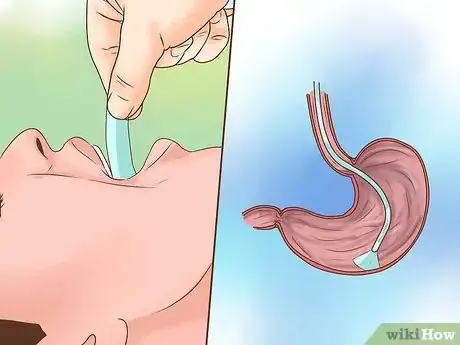
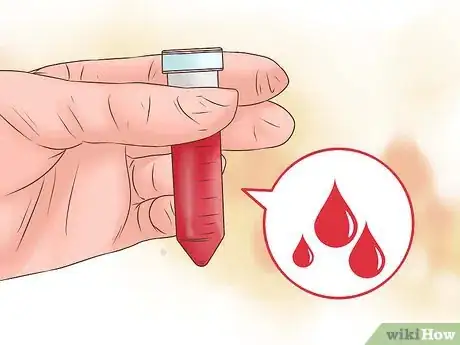

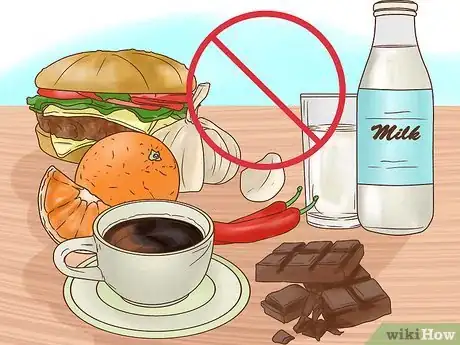
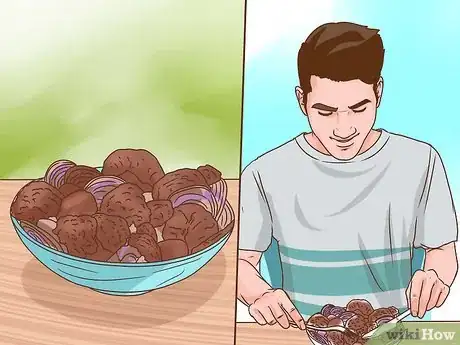
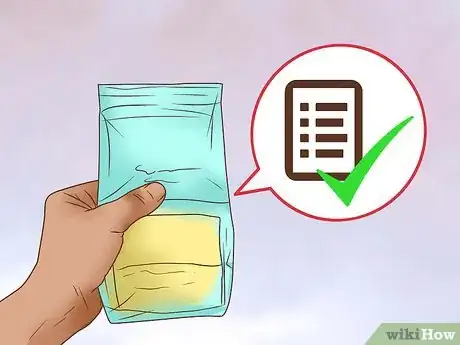
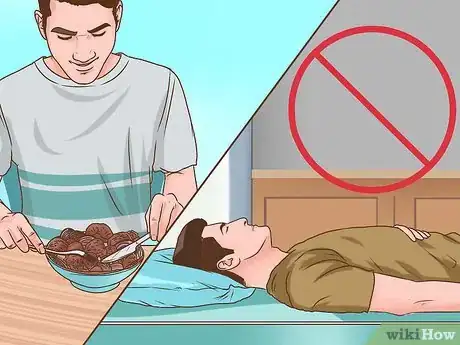

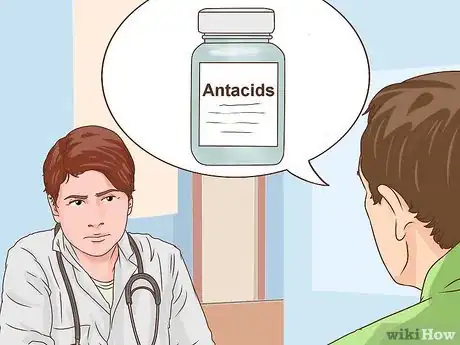

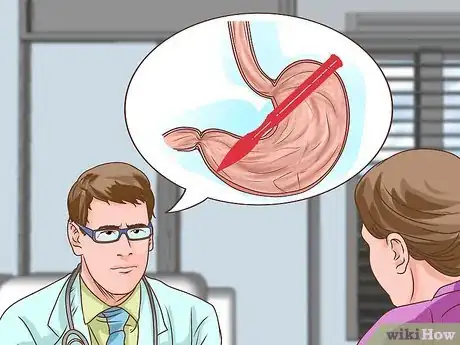




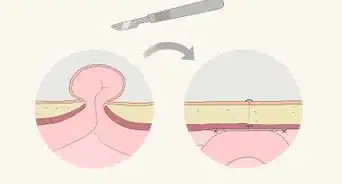


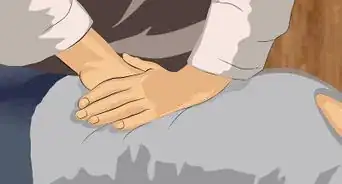
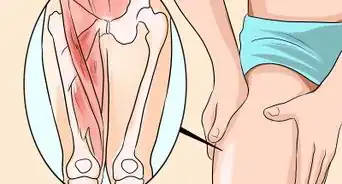
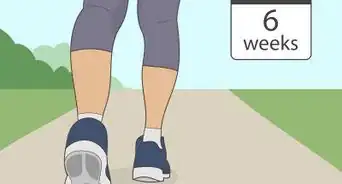
















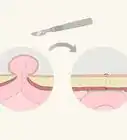



































Medical Disclaimer
The content of this article is not intended to be a substitute for professional medical advice, examination, diagnosis, or treatment. You should always contact your doctor or other qualified healthcare professional before starting, changing, or stopping any kind of health treatment.
Read More...